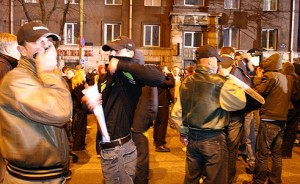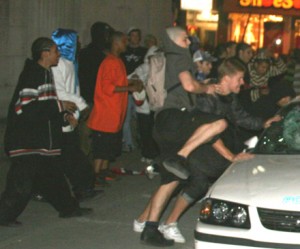November
18
ELA 20: Nov 18 Ch 16, Mob mentality, and a 1960’s audience …
- We had only a few paragraphs to complete from Chapter 15 and then discussed the significance of that chapter for the novel. Scout runs through the mob shadowed in darkness, not knowing they were strangers to her, but after realizing she doesn’t recognize anyone she panicks. She picks out one face she knows, though, and that is of Mr. Cunningham, her friend’s father and the man Atticus had recently helped with legal affairs. Mr. Cunningham originally ignores Scout as she tries to make conversation with him, making Scout uncomfortable. The interesting thing here is that Scout doesn’t suddenly become uncomfortable because it dawns on her the danger in the situation, with angry men surrounding her father wanting Tom Robinson. Instead, her awareness only comes from the fact that everyone is staring at her and no one is responding – it’s the silence in the conversation that makes her uncomfortable and this is clearly not why the rest of the people present are tense.
- We pointed out and discussed, as well, why Jem disobeyed his father’s direct command – to take the children home. Jem didn’t verbally defy his father but stood firm in his spot and refused to move. From our discussion, we believe this had an impact on the events turning out the way they did as well.
- We also looked at some pictures of people in mobs – there are different types. Some are just in the crowd and look no different than they would on their own on the street. These others, though, have their clothing fashioned just so to cover their faces, necks, any distinguishable features. Some even look like they’ve dressed specifically for the occasion, like they planned to hide their face giving the impression of some pre-meditation on their part. There’s a different between people who are in a crowd and an event occurs that they join in on without having previously planned it, verses those who plan their actions and go out looking to cause problems.

 Looking at these pictures, though, we considered what their response would be in the moment if someone addressed them by name, whether it would slow them down or they would have to be more responsible with their actions, understanding there were possible consequences. That’s the important thing to understand about this event in Chapter 16 – that the men were there as a crowd and not concerned with their own individual responsibility. When Scout forced one man to recognize he was still an individual, that man realized he was there and about to do something he shouldn’t, causing him to call it off and convince the others to retreat as well.
Looking at these pictures, though, we considered what their response would be in the moment if someone addressed them by name, whether it would slow them down or they would have to be more responsible with their actions, understanding there were possible consequences. That’s the important thing to understand about this event in Chapter 16 – that the men were there as a crowd and not concerned with their own individual responsibility. When Scout forced one man to recognize he was still an individual, that man realized he was there and about to do something he shouldn’t, causing him to call it off and convince the others to retreat as well.- We also talked about the symbolism of the lightbulb Atticus takes to the jail house. Atticus represents the light that would not have been there otherwise. Had he not been there, the men would not have seen the error of their ways and carried out some dangerous things. With Atticus there, and Scout later as well, to shed some “light” (both figurative and literal) on their intentions, they fell back and changed their minds. Atticus represents the “light” to more than just these people, but also to people in his community who disagree with a Black man having a trial against a white person’s word.
- We discussed later in Chapter 16 the social environment the author was targetting her novel to. She included parts of the novel that were meant to be directly spoke to the reader, not just between characters in the fictional story. The dialogue between Jem, Scout, and Dill regarding the significance of having “one drop of Negro blood” in them is meant to be a sharp criticism to Harper Lee’s current society, one that hadn’t yet given up on the idea that colour meant so much. For these students, who have only grown up in a society where legal protections ensured people were treated equally despite race, it’s difficult for them to understand a time when people were so clearly segregated or discriminated against. For the author, though, it was a brave thing to address an issue that had been slowly changing but had firm roots in her country’s tradition.